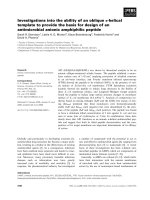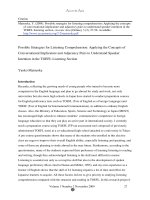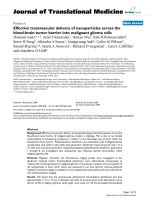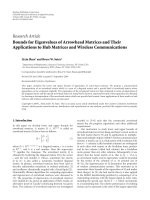Nanoparticles of biodegradable polymers for delivery of therapeutic agents and diagnostic sensitizers to cross the blood brain barrier (BBB) for chemotherapy and MRI of the brain
Bạn đang xem bản rút gọn của tài liệu. Xem và tải ngay bản đầy đủ của tài liệu tại đây (1.96 MB, 93 trang )
NANOPARTICLES OF BIODEGRADABLE POLYMERS
FOR DELIVERY OF THERAPEUTIC AGENTS AND
DIAGNOSTIC SENSITIZERS
TO CROSS THE BLOOD BRAIN BARRIER (BBB) FOR
CHEMOTHERAPY AND MRI OF THE BRAIN
CHEN LIRONG
(B.Sc)
A THESIS SUBMITTED
FOR THE DEGREE OF MASTER OF SCIENCE
GRADUATE PROGRAM IN BIOENGINEERING
NATIONAL UNIVERSITY OF SINGAPORE
2005
ACKNOWLEDGEMENTS
The completion of this project would not have been possible without the help and
support from many. I would like to thank the following people for their great
contributions to my M.Sc. research.
z
My supervisor Prof. Feng Si-Shen and co-supervisor Prof. Sheu Fwu-Shan for
their careful and enthusiastic guidance and assistance in my project.
z
Professor Wang Shih-Chang and Dr Shuter Borys, Department of Dognostic
Radiology, National University Hospital for their great help in MRI work.
z
My fellow colleagues, Dong Yuancai, Khin Yin Win, Yu Qianru, Zhang Zhiping,
and Zhou Hu. They have offered me enormous helps in the project.
z
Graduate Program in Bioengineering and The Division of Bioengineering,
National University of Singapore for the postgraduate scholarship.
z
My family and my husband Jiang Xuan. They have been encouraging and
supporting me all along.
i
TABLE OF CONTENTS
ACKNOWLEDGEMENTS
i
TABLE OF CONTENTS
ii
SUMMARY
v
NOMENLCATURE
vii
LIST OF FIGURES
viii
LIST OF TABLES
x
CHAPTER ONE: INTRODUCTION
1
1.1 BLOOD BRAIN BARRIER
1
1.1.1 History and Anatomy of the Blood Brain Barrier
1
1.1.2 Functions of the Blood Brain Barrier
4
1.1.3 Clinical Significance of the Blood Brain Barrier
6
1.2 METHODS TO OVERCOME THE BLOOD BRAIN BARRIER
7
1.3 NANOPARTICLES TO CROSS THE BLOOD BRAIN BARRIER
10
1.4 RESEARCH OBJECTIVES
11
1.4.1 In Vitro Evaluation of PLGA Nanoparticles for Paclitaxel Delivery Across 13
the Blood Brain Barrier
1.4.2 Gd-DTPA Loaded Nanoparticles of Biodegradable Polymers for MRI of 15
the Brain
1.5 THESIS ORGANIZATION
16
CHAPTER TWO: LITERATURE REVIEW
17
2.1 CANCER, CHEMOTHERAPY, AND CONTROLLED DRUG DELIVERY
17
2.2 BRAIN CANCER AND OTHER BRAIN DISEASES
20
2.3 NANOPARTICLE TECHNOLOGY
21
2.3.1 Introduction of Nanoparticles
21
2.3.2 Fabrication techniques of Nanoparticles
22
2.3.2.1 Dispersion of performed polymers
22
ii
2.3.2.2 Polymerization methods
24
2.4 BIODEGRADABLE POLYMERS IN CONTROLLED DRUG DELIVERY
25
2.4.1 Biodegradable Polymers in Drug Delivery Systems
25
2.4.2 Poly(lactide-co-glycolide) (PLGA)
28
2.4.3 Poly(Lactic acid)-poly(ethylene glycol) (PLA-PEG) Copolymers
29
2.5 NANOPARTICLES OF BIODEGRADABLE POLYMERS TO PENETRATE THE 30
BLOOD BRAIN BARRIER
2.5.1 Ideal Properties of Nanoparticles across the Blood Brain Barrier
30
2.5.2 Possible Mechanism of Nanoparticles to Penetrate the Blood Brain Barrier
31
2.5.3 Surface Modification of Nanoparticles
33
2.6 MRI AND MRI CONTRAST MEDIUM
34
CHAPTER THREE: MATERIALS AND METHODS
36
3.1 MATERIALS
36
3.2 METHODS
37
3.2.1 In Vitro Evaluation of PLGA Nanoparticles for Paclitaxel Delivery Across 37
the Blood Brain Barrier
3.2.1.1 Fabrication of nanoparticles
37
3.2.1.2 Nanoparticles characterizations
37
3.2.1.3 Encapsulation efficiency of paclitaxel
38
3.2.1.4 In vitro release of paclitaxel
39
3.2.1.5 Cell culture and cellular uptake experiments
40
3.2.2 Gd-DTPA Loaded Nanoparticles of Biodegradable Polymers for MRI of 41
the Brain
3.2.2.1 Fabrication of nanoparticles
41
3.2.2.2 Encapsulation efficiency of Gd-DTPA
42
3.2.2.3 In vitro release of gadolinium
42
3.2.2.4 In vitro and in vivo MRI
42
CHARPTER FOUR: RESULTS AND DISCUSSION
44
4.1 IN VITRO EVALUATION OF PLGA NANOPARTICLES FOR PACLITAXEL 44
iii
DELIVERY ACROSS THE BLOOD BRAIN BARRIER
4.1.1 Particle Size and Size Distribution
44
4.1.2 Zeta Potential
48
4.1.3 Drug Loading and Drug Encapsulation Efficiency (EE) of Paclitaxel
50
4.1.4 Morphology
54
4.1.5 In Vitro Release of Paclitaxel
57
4.1.6 Cell Culture
59
4.1.7 Cellular Uptake of Nanoparticles
61
4.2 GD-DTPA LOADED NANOPARTICLES OF BIODEGRADABLE POLYMERS 65
FOR MRI OF THE BRAIN
4.2.1 Particle Size
65
4.2.2 Morphology
67
4.2.3 Loading and Encapsulation Efficiency of Gadolinium
69
4.2.4 In Vitro Release of Gadolinium
71
CHARPTER FIVE: CONCLUSIONS AND FUTURE WORK
73
5.1 CONCLUSION
73
5.2 FUTURE WORK
74
REFERENCE
75
PUBLICATION LIST
82
iv
SUMMARY
Blood brain barrier (BBB) was first discovered by Dr. Paul Enrilich in the late 19th
century. It is a physiological barrier existing for molecular transportation between the
blood and the central nervous system (CNS). BBB plays an important role in
maintaining a homeostatic environment for a healthy and efficient brain and
protecting the brain from harmful chemicals. However, it is considered to be the main
obstacle for a large number of drugs to enter the brain. Nanoparticles provide a
feasible choice as a drug delivery device to cross the BBB because it may overcome
the biological barrier and increase the bioavailability of the drug in the brain and CNS.
The aim of this thesis is to develop nanoparticles of biodegradable polymers for drug
delivery across the blood brain barrier. Emphasis is given to investigate the possible
effects of the particle surface coating. The work can be divided into two parts. In the
first part, poly(lactic-co-glycolic acid) (PLGA) nanoparticles were prepared by a
modified single emulsion solvent evaporation method. Anti-cancer drug paclitaxel or
fluorescent marker coumarin-6 was encapsulated in the PLGA nanoparticles. PVA
and Vitamin E TPGS were used as emulsifiers. Tween 80, poloxamer 188 and
poloxamer 477 were used as coating materials to modify the surface of the
nanoparticles. Nanoparticles of various recipes were characterized by various stateof-the art techniques. A model cell line, Madin-Darby Canine Kidney (MDCK) cell
line, was used to simulate BBB to investigate the feasibility of the nanoparticles to
cross the blood brain barrier as well as the effects of the surface coating. In vitro
uptake of fluorescent nanoparticles by MDCK cells was evaluated qualitatively by
v
microreader and quantitatively by confocal laser scanning microscopy. In cellular
uptake experiments of nanoparticles, it was found that all the nanoparticles can be
internalized by the MDCK cells to certain extent and the percentage of the cellular
uptake of the nanoparticles was highly affected by the surface coating. It was thus
concluded that it is feasible for nanoparticles of biodegradable polymers to deliver
drugs across the blood brain barrier and the surface coating plays key roles in
determining the extent of the particles to cross the BBB.
To further investigate the potential for the nanoparticles to cross the BBB, animal
testing is important and necessary. The second part of the thesis is thus focused on a
feasibility investigation for polymeric nanoparticles to deliver contrast materials
across the BBB for brain image. Gadolinium-DTPA(Gd-DTPA) loaded PLGA or
poly(Lactic acid)- poly(ethylene glycol) (PLA-PEG) nanoparticles were made by the
nanoprecipitation and in vivo animal investigation was carried out to evaluate the
effects of surface coating on magnetic resonance imaging (MRI). It was found that
PLA-PEG nanoparticles of size less than 100 nm and PLGA nanoparticles of
diameter less than 200 nm can be manufactured by the nanoprecipitation method.
0.92-1.74% loading of Gd-DTPA was obtained in the particles. In vivo MRI is still
under development.
vi
NOMENCLATURE
BBB
Blood brain barrier
DCM
Dichloromethane
DMEM
Dulbecco’s modification of Eagle’s medium
EE
Encapsulation efficiency
Gd-DTPA
Gadolinium DTPA
HBSS
Hank’s balanced salt solution
HPLC
High performance liquid chromatography
ICP-AES
Inductively Coupled Plasma - Atomic Emission Spectrometer
MDCK
Madin-Darby canine kidney
MDR
Multidrug resistance
MRI
Magnetic Resonance Imaging
MRP
Multidrug resistance protein
P-gp
P-glycoprotein
PLA-PEG
Poly (Lactic acid) - poly(ethylene glycol)
PLGA
Poly (D, L-lactide-co-glicolide)
PVA
Polyvinyl alcohol
Vitamin E TPGS
vitamin E succinate with polyethylene glycol 1000
vii
LIST OF FIGURES
Fig.1 The blood brain barrier
Fig. 2 The BBB as an impermeable wall.
Fig. 3 The BBB as a selective sieve.
Fig. 4 Chemotherapy cycles
Fig. 5 Drug levels in the blood with (Left) traditional drug dosing and (Right)
controlled delivery dosing
Fig. 6 Chemical structure of Gd-DTPA
Fig. 7 Chemical structure of PVA and VE-TPGS
Fig. 8 Encapsulation efficiency of the nanoparticles. Sample 1 is PVA emulsified
nanoparticles. Sample 5 is TPGS emulsified nanoparticles.
Fig. 9 Chemical structure of paclitaxel
Fig. 10 Drug content of the nanoparticles.
Fig. 11 SEM and AFM images of the nanoparticles (from top to bottom: Sample
1,PVA emulsified nanoparticles; sample 2, PVA emulsified Tween 80 coated
nanoparticles; sample 3, PVA emulsified poloxamer 188 coated nanoparticles; sample
4, PVA emulsified poloxamer 407 nanoparticles; sample 5, TPGS emulsified
nanoparticles).
viii
Fig. 12 The release profile of paclitaxel from the nanoparticles in PBS
Fig. 13 Morphology of MDCK cells at low density (left) and high density (right).
Fig. 14 Morphology of bovine brain microvascular endothelial cells (BBMVEC)
Fig. 15 Cellular uptake of nanoparticles in MDCK cells
Fig. 16 Confocal laser scanning microscope images of PLGA nanoparticles
internalized in MDCK cells ( Sample 1,PVA emulsified nanoparticles; sample 2,
PVA emulsified Tween 80 coated nanoparticles; sample 3, PVA emulsified
poloxamer 188 coated nanoparticles; sample 4, PVA emulsified poloxamer 407
nanoparticles; sample 5, TPGS emulsified nanoparticles)
Fig. 17 SEM image of PLGA nanoparticle
Fig. 18 SEM image of PLA-PEG nanoparticles
Fig. 19 Release of gadolinium from the nanoparticle
ix
LIST OF TABLES
Table 1 Drug delivery to CNS: technical approaches, advantages and limitations
Table 2 Structures of biodegradable polymers usually used in drug delivery.
Table 3 Ideal properties of polymeric-based nanoparticles for drug delivery across
the BBB.
Table 4 Size and size distribution of different nanoparticles.
Table 5 Zeta potential of different nanoparticles
Table 6 The size and polydispersity of the Gd-DTPA loaded particles
Table 7 Encapsulation efficiency and drug content of the Gd-DTPA loaded
nanoparticles
x
CHAPTER ONE
INTRODUCTION
1.1 BLOOD BRAIN BARRIER
Blood brain barrier (BBB) exists between the blood and the central nervous system
(CNS), which is a physiological barrier for molecular transportation between the
blood and the CNS.
It provides neurons with precisely controlled nutritional
requirements to maintain a proper balance of ions and other chemical constituents and
isolate the central nervous systems from toxic chemicals in the blood.
1.1.1
History and Anatomy of Blood Brain Barrier
It was in the late 19th century that the concept of blood-brain barrier arose. The
German bacteriologist Paul Ehrlich, the 1908 Nobel Laureate of Medicine and the
Father of Chemotherapy, observed that certain dyes, e.g., a series of aniline derivates,
administered intravenously to small animals, stained all the organs except for the
brain [1]. In subsequent experiments, Edwin E. Goldmann, a student of Ehrlich,
injected the dye trypan blue directly into the cerebrospinal fluid of rabbits and dogs.
He found that the dye readily stained the entire brain but did not enter the blood
stream to stain the other internal organs [2]. The observations drawn from the dye
studies indicated that the central nervous system is separated from the blood system
by a barrier of some kind. Lewandowsky, while studying potassium ferrocyannide
1
penetration into the brain, was the first to coin the term blood-brain barrier and called
it "bluthirnschranke" [3].
In the 1960s, Reese and Karnovsky [4] and Brightman and Reese [5] repeated the
Ehrlich/Goldmann experiments at the ultrastructural level by using electron
microscopy to observe the distribution of the protein tracer horseradish peroxidase
following intravenous or intrathecal administration. These experiments conclusively
identified the brain capillary endothelial cell as the site of the brain blood barrier.
Later experiments demonstrated that the BBB is composed of epithelial tight
junctions between the plasmalemma of adjacent cells in cerebral capillaries and is
surrounded by astrocyte foot process [5, 6]. Fig. 1 below shows the diagram of the
blood brain barrier in detail. The brain capillary is lined with a layer of special
endothelial cells that lack fenestrations and is sealed with tight junctions.
Fig 1 The blood brain barrier
2
The tight junctions between endothelial cells results in a very high transendothelial
electrical resistance of 1500-2000 Ω.cm2 compared to 3-33 Ω.cm2 of other tissues
which reduces the aqueous based paracellular diffusion that is observed in other
organs [7, 8]. The normal blood brain barrier restricts trans- and paracellular
movement of blood-born molecules, effectively filtering most ionized, water-soluble
molecules greater than 180 Daltons in mass [9, 10]. In the case of brain tumor, the
blood brain barrier is frequently not intact in the center of the malignantly as
demonstrated by computerized tomography and MR imaging [9]. However, the
presence of an intact blood brain barrier at the proliferating edge of the tumor has
been suggested to be one of the major contributing factors to the failure of
chemotherapy in the treatment of central nervous system neoplasms [11, 12].
Comparing brain and general capillaries, brain capillaries are structurally different
from the blood capillaries in other tissues, which result in the properties of the blood
brain barrier. Brain capillaries lack the small pores that allow rapid movement of
solutes from circulation into other organs. In brain capillaries, intercellular cleft,
pinocytosis, and fenestrae are virtually nonexistent; exchange must pass
transcellularly. Therefore, only lipid-soluble solutes that can freely diffuse through
the capillary endothelial membrane may passively cross the BBB. In capillaries of
other parts of the body, such exchange is overshadowed by other nonspecific
exchanges. Moreover, there are astrocytes foot processes or limbs that spread out and
abutting one other, encapsulate the capillaries closely associated with the blood
vessels to form the BBB.
3
Recent progress in molecular biology revealed that multi-drug efflux pump proteins
such as P-glycoproteins (p-gp), multidrug resistance protein (MRP) are rich in the
brain capillaries endothelial cell membrane, which may also play a key role to
constitute the BBB. These proteins are active transport systems responsible for
outward transport of a wide range of substances [13]. Both P-gp and MRP are
membrane proteins belonging to the ABC (ATPbinding cassette) transport protein
family and can confer multidrug resistance (MDR). They are energy-dependent
pumps located in the BBB, sharing some functional similarities (somewhat
overlapping substrate specificities) with broad substrate specificity. Evidence shows
that P-gp excludes a number of lipophilic compounds from cerebral endothelial cells
[14]. Many MRP substrates are amphiphilic anions with at least one negatively
charged group although MRP can also transport cationic and neutral compounds. It
appears that there are two mechanisms for transport of MRP substrates dependent on
their ionic nature: direct transport of anionic compounds, whereas, for some cationic
and neutral compounds the presence of glutathione, likely via cotransport, is required
[13].
1.1.2 Functions of the Blood Brain Barrier
The main function of the blood brain barrier is to protect the brain. The BBB serves
as an impermeable wall to prevent the entry of agents from outside of the brain [15].
It has been identified that the brain capillary endothelial cell as the physical site of the
BBB. The continuous tight junctions that seal together the margins of the endothelial
cells play very important roles in forming the blood brain barrier. Furthermore, in
4
contrast to endothelial cells in many other organs, brain capillary endothelial cells
contain no direct transendothelial passageways such as fenestrations or channels.
Fig 2 The BBB as an impermeable wall.
However, the blood brain barrier cannot be absolute. It must facilitate the exchange of
selected solutes to deliver metabolic substrates and remove metabolic wastes.
Therefore, the blood brain barrier also serves as a selective sieve [15]. Lipid-soluble
fuels and waste products, such as O, and CO, can readily cross the lipid bi-layer
membranes of the endothelial cell and, thus, encounter little difficulty in quickly
exchanging of metabolic molecules between blood and brain. Polar solutes such as
glucose and amino acids, however, must depend on other mechanisms to facilitate
their exchange. This is accomplished by the presence of specific, carrier-mediated
transport proteins in the luminal and abluminal membranes of the brain capillary
endothelial cell.
5
Fig 3 The BBB as a selective sieve.
With these two functions of the blood brain barrier, the brain capillaries allow the
passage of oxygen and other essential chemicals and shield the brain from toxins in
the circulatory system and from biochemical fluctuations and, consequently provide a
safe environment to the brain.
1.1.3 Clinical Significance of the Blood Brain Barrier
Blood brain barrier serves to protect the brain from toxic agents. However, it also
becomes an insurmountable obstacle for a large number of drugs. Almost all of the
lipophilic anticancer agents such as doxorubicin [16, 17], epipodophylotoxin and
vinca alkaloids [18] hardly enter the brain. As a consequence, the therapeutic value of
many promising drugs is diminished, and brain tumors and other CNS diseases such
as alzheimer’s disease [19], Parkinson’s disease [20] and HIV infection [21] have
proved to be most refractory to therapeutic interventions. There are twice as many
people suffering from central nervous system diseases as those suffering from
6
diseases of the blood vessels and heart. However, the world-wide CNS drug market is
US$33 billion, which is only half of the size for the latter diseases [22]. This is all
because of the blood brain barrier. For all these diseases that occur in the central
nervous systems, the biggest problem is how to overcome the blood brain barrier.
1.2 METHODS TO OVERCOME THE BLOOD BRAIN BARRIER
To solve the problems encountered in treatment of brain diseases, a lot of efforts have
been made and various strategies for enhanced CNS drug delivery have been
proposed [8, 23-27]. These strategies can be divided into three categories:
manipulating drugs, disrupting the blood brain barrier and finding alternative routs for
drug delivery. Drug manipulation includes lipophilic analogs [28], prodrugs [29-31],
chemical drug delivery [32, 33], carrier-mediated drug delivery [34], and
receptor/vector mediated drug delivery [35-39]. Disturbing the blood brain barrier
includes osmotic blood brain barrier disruption [40-44] and biochemical blood brain
barrier disruption [45-47]. Alternative routes to CNS drug delivery include
intraventricular/intrathecal route [48], and olfactory pathway [49-51]. Besides these
methods, there were some direct ways of circumventing the BBB. That is to deliver
drugs directly to the brain interstitium, which includes injections, catheter, and pumps
[52, 53]; biodegradable polymer wafers [54, 55], microspheres and nanoparticles; and
drug delivery from biological tissues [56].
Table 1 shown below summarizes the technical approaches, their advantages and
limitations.
7
Table 1 Drug delivery to CNS: Technical approaches, advantages and limitations
[19].
Technical
approach
Non-invasive
Lipophilic
analog
Advantages
Limitations
Readily penetrate CNS e.g. Heroin
and analogues of nitrosoureas
Poor aqueous solubility, limit
to 400-600 dalton molecular
weight for BBB threshold,
enhanced peripheral
distribution
Delivered without disulfide or ester
linkages, which affect
pharmacological actions
Liposomes/PE
Gylated/PEGyl
ated immunoliposomes
Capable of receptor-mediated
transport through the BBB in-vivo
Do not undergo significant
transport through the BBB in
the absence of vectormedicated drug delivery
Prodrug
High drug residence time e.g, Fatty
acid, glyceride or phospholipids
precursors of levodopa, GABA,
Niflumic acid, valproate or vigabatrin
and suitable for specific membrane
transporter, such as the amino acids,
peptide or glucose transporter.
Poor selectivity, poor
retention, and the possibility
for reactive metabolites. Dose
limited toxicity.
Chemical drug
delivery
Site-specific drug delivery e.g,
neuropeptides
The oxidative lability and the
hydrolytic instability combine
to limit the shelf-life of the
CDs.
Redox
chemical
delivery
systems
Increases intracranial concentrations
of a variety of drugs including
neurotransmitter, antibiotics, and
antineoplastic agents.
Carrier
mediated drug
delivery
Controls the delivery and retention of
drugs, e.g., Levodopa and melphalin.
Highly stereospecific drug is
to be converted into a
structure similar to that of an
endogenous nutrient.
8
Receptor/Vecto
r medicated
drug delivery
Allows designing transport linker to
suit the specific functional needs of
the therapeutic agents, includes
peptide-based pharmaceuticals and
small molecules incorporated without
liposomes.
Saturable process, enzymatic
dependent release, attachment
to a BBB transport vector
renders certain drug inactive.
Osmotic blood
brain barrier
disruption
Alters barrier-inducing factors, e.g.,
cytotoxic drugs
Often leads to unfavorable
toxic/ therapeutic ratio and
breaks down the self-defence
mechanism of the brain
Promising delivery strategy for
recombinate adenoviral vector,
magnetic resonance imaging agents
and macromolecular drugs.
Biochemical
blood brain
barrier
disruption
Selective opening of brain tumor
capillaries e.g. intracarotid infusion of
leukotriene C4
Breaks down the self-defense
mechanism of the brain.
Olfactory
Pathway
Direct nose-to-brain transport and
access to CSF e.g. neurotropic factors.
Enzymatically active, low PH
nasal epithelium, mucosal
irritation or variability caused
by nasal phthology.
Bypasses the BCB and results in
immediate high CSF drug
concentrations, encounter minimized
protein binding and decreased
enzymatic activity, longer drug halflife.
Slow rate of drug distribution
within the CSF and increase
in intracranial pressure results
into high clinical incidence of
hemorrhage, CSF leaks,
neurotoxicity and CNS
infections.
Invasive
Intraventricular
/ Intrathecal
Route
Injections,
Catheters, and
Pumps
Continuous drug delivery. Distribution Due to diffusion problems, the
of drugs can be maintained.
therapeutic agent in likely to
reach only nearby sites.
Biodegradable
polymer
Wafers,
Microspheres
and
Nanopartices
Circumvent the BBB, controlled drug
delivery
Useful in a very limited
number of patients.
Polymeric cytokine delivery obviating
the need for transfecting cytokine
genes, produces longer periods of
cytokine release in-vivo and yield
more reproducible cytokine release
Due to diffusion problems, the
therapeutic agents is likely to
reach only nearly sites
(<1mm).
9
profile and total cytokine dose.
General toxic effect is a
serious impediment,
Easily implantable without damage
Drug Delivery
from
Biological
Tissues
Therapeutic proteins can be released
from co-grafted cells
Inefficient transfection of host
cells, nonselective expression
of the transgene and
deleterious regulation of the
transgene by the host.
All the methods mentioned above have advantages and limited factors. Among these
methods, nanoparticles of biodegradable polymers have shown to be one of the
promising strategies.
1.3 NANOPARTICLES TO CROSS THE BLOOD BRAIN
BARRIER
Nanoparticles are solid colloidal particles ranging in size from 10 to 1000 nm, in
which therapeutic drugs can be adsorbed, entrapped, or covalently attached [57].
Formulated by nanoparticles, drugs can be released at right rate and dose at specific
sites in body during a certain time to realize the accurate delivery which will enhance
the therapeutic efficacy and reduce the side effects.
The potential advantages of nanoparticles for drug delivery across the BBB include
[58]:
1. Nanoparticle system can deliver a relatively more concentrated drug dose to the
brain, compared to that for the prodrug or drug-vector approach, reducing the needed
dose and thus the drug-associated side effects;
10
2. Nanoparticles of small enough size may have ability to transport through the tight
junction (knealing between endothelial cells, paracelluar transportation);
3. Nanoparticles are capable of bypassing the P-gp efflux system. Nanoparticles may
be equipped with a mask (surface coating) to the p-gp to bring the drug molecules
across the BBB;
4. Nanoparticles may offer protection for the activity of the drug molecules during
transportation in the circulation, across the BBB and in the brain;
5. Nanoparticles may provide sustained release of drug in the brain to prolong the
pharmacological action of drug molecules;
6. Nanoparticle formulation is a platform technology, which can be applicable to a
wide range of drugs, either hydrophilic or lipophilic.
7. Nanoparticles of small enough size and appropriate coating may have ability to
escape from the elimination by the RES to realize long-circulating properties,
1.4 RESEARCH OBJECTIVES
Until now, only a few papers have been published on using nanoparticles to deliver
across the BBB therapeutic agents for chemotherapy and contrast materials for
medical imaging of the brain. However, most of them were focused on using
poly(butylcyanoacrylate) (PBCA) nanoparticles with surface coating of polysorbate
80. Despite the success of PBCA nanoparticles for drug/peptide delivery across the
BBB, this kind of nanoparticles has its disadvantages. Firstly, this polymer is not
11
authorized to application in human (not FDA-approved). Secondly, there have been
reports of in vivo toxicity of PBCA-polysorbate 80 nanoparticles. Olivier et al
reported that PBCA nanoparticle caused mortality (3 to 4 out of 10 mice) and
dramatically decreased locomotor activity in mice dosed with dalargin loaded PBCA
nanoparticles, but not with non biodegradable polystyrene nanoparticles (the latter did
not show any CNS penetration of dalargin) [59]. It was concluded by the researchers
that a non specific permeabilization of the BBB, probably related to the toxicity of the
carrier, may account for the CNS penetration of dalargin associated with PBCA
nanoparticles and polysorbate 80. Considering the in vivo toxicity reported on the
PBCA nanoparticle system, FDA-approved biodegradable polymers such as PLGA
and PLA-PEG were used in this project. Our main objective is to developed an
appropriate nanoparticle technology to make PLGA and PLA-PEG nanoparticles of
small enough size and appropriate surface coating to deliver therapeutic agents and
contrast materials across the blood brain barrier for chemotherapy and medical
imaging of the brain, respectively. The project can be divided into two parts. In the
first part, paclitaxel loaded PLGA nanoparticles will be prepared by a modified single
emulsion method and characterized by various state-of-the art techniques. In vitro
evaluation of such nanoparticles to cross the blood brain barrier will be investigated
by employing MDCK cell line as an in vitro model of the BBB. The effects of the
surface coating will be studied. In the second parts, gadolinium-DTPA loaded PLGA
and PEG-PLA nanoparticles will be prepared by the nanoprecipitation method, which
will be injected in animals for in vivo magnetic resonance imaging (MRI).
12
1.4.1 In Vitro Evaluation of PLGA Nanoparticles for Paclitaxel Delivery Across
the Blood Brain Barrier
PLGA is used in this research because of its biodegradability and biocompatibility. It
is approved by US Food and Drug Agency (FDA). PLGA nanoparticles were usually
prepared in the literature by single emulsion solvent evaporation method with
polyvinyl alcohol (PVA), a commercial macromolecule product as the emulsifier [60].
However, despite repeated washing, a fraction of PVA may always remain on the
nanoparticle surface because PVA forms an interconnected network with the polymer
at the interface [61]. The residual PVA associated with PLGA nanoparticles may
have side effects and affect the physical properties and cellular uptake of the
nanoparticles. To reduce or remove the negative effects of the residual PVA, surface
modification of the particles will be carried out by surface coating or replacing the
PVA emulsifier by a natural emulsifier such as phopspholipid or PEGylated vitamin
E 9full name, or Vitamin E-TPGS or TPGS). Three coating materials, Tween 80,
poloxamer 188 and poloxamer 407 will be used in the study. These materials are all
ampiphilic polymers and may change the hydrophobicity of the particle surface.
Tween 80 has been reported to be useful for overcoming the blood brain barrier with
PBCA nanoparticles [62, 63-65]. Poloxamers have been reported to help the particles
prolong the time in the blood stream by forming a steric stabilizing layer of PEG on
the surface of the particle [66, 67]. TPGS has shown to be an effective emulsifier
which can achieve high drug encapsulation efficiency, size and size distribution,
morphological and physicochemical properties, desired in vitro release kinetics of the
nanoparticles, and high cellular uptake of nanoparticles [68-71]. In this study the
13
effects of all these surfactants on the feasibility of nanoparticles to penetrate the blood
brain barrier will be investigated.
Paclitaxel (Taxol®) is one of the most potent antitumor agents and has been
apptroved by FDA for treatment of a wide spectrum of cancers, especially breast
cancer, ovarian cancer, small cell and non small cell lung cancer [72-76]. It has also
been used to treat malignant glioma and brain metastases [77-79]. However, brain
tumors constitute a difficult problem and the therapeutic benefit of paclitaxel has been
limited. This could be attributed to delivery problem to cross the BBB. Although
paclitaxel is very lipophilic, concentrations in the CNS were found very low after
intravenous administration [80, 81]. It was demonstrated that the p-gp blocker
valspodar enhances paclitaxel entry into the brains of mice after intravenous dosing
and that valspodar dramatically increases paclitaxel effectiveness against a human
glioblastoma implanted into the CNS of nude mice [82]. These represent the
preliminary data directly demonstrating the role of p-gp in limiting the therapeutic
availability of paclitaxel to the CNS.
In this study, paclitaxel loaded PLGA nanoparticles will be prepared by single
emulsion solvent evaporation method. Madin-Darby canine kidney (MDCK) cell line
will be used as an in vitro model of the BBB. MDCK is a kidney epithelial cell line,
which forms a tight monolayer similar to that of the brain endothelial cell monolayer.
MDCK cells display morphological and enzymatic characteristics also found in the
brain endothelial cells (e.g., acetylcholinesterase, butyryl-cholinesterase, gammaglutamyl transpeptidase). MDCK monolayer represents a relatively simple model for
14









